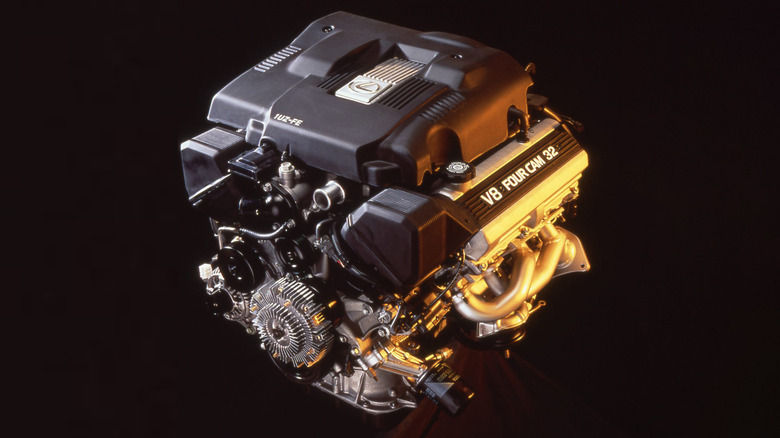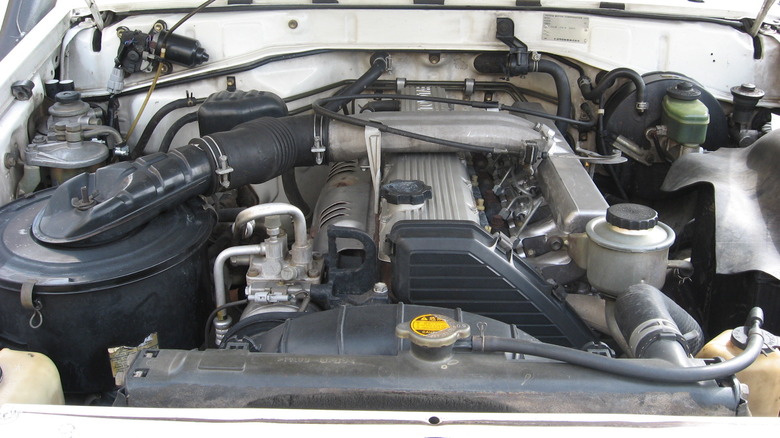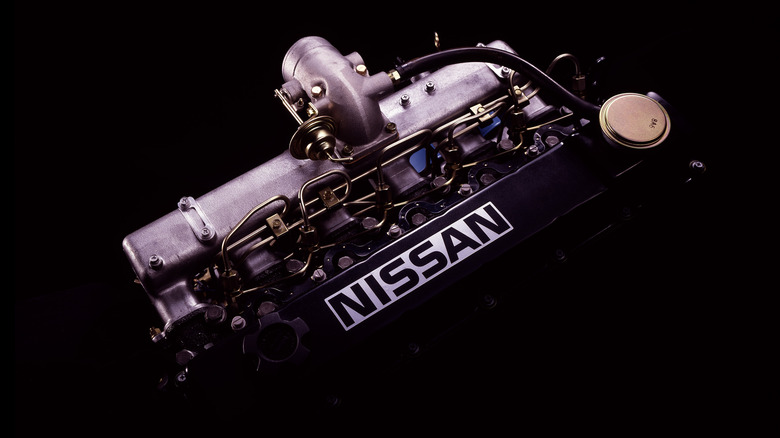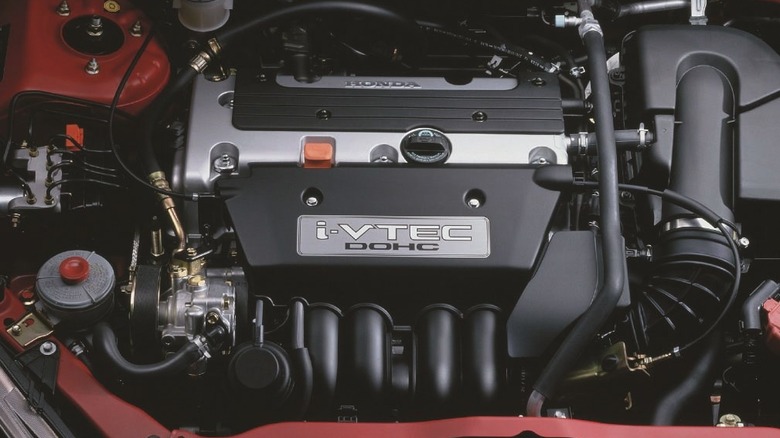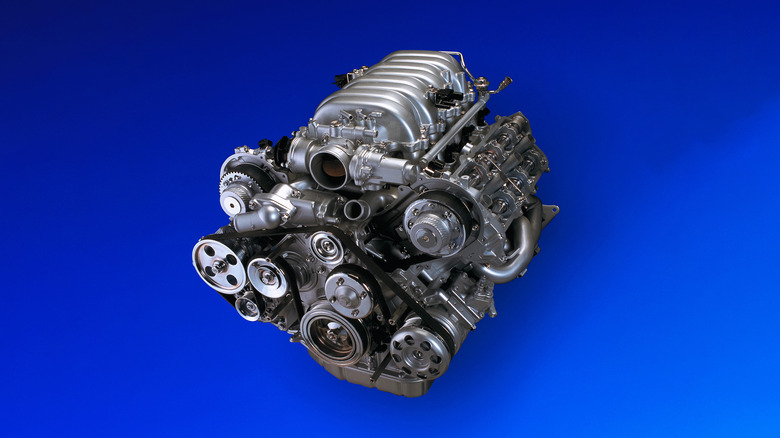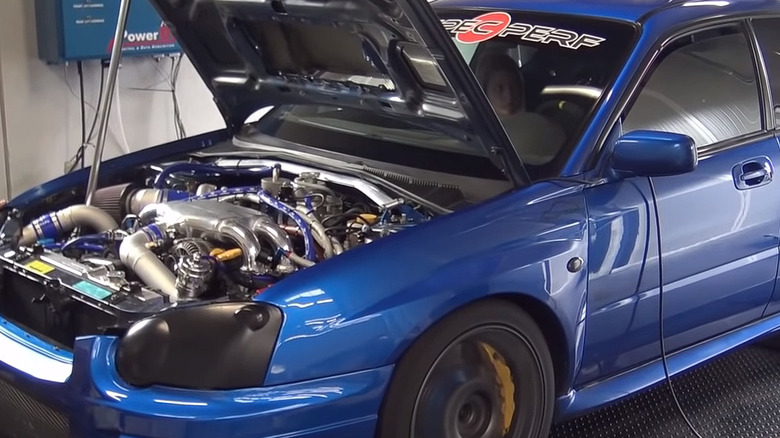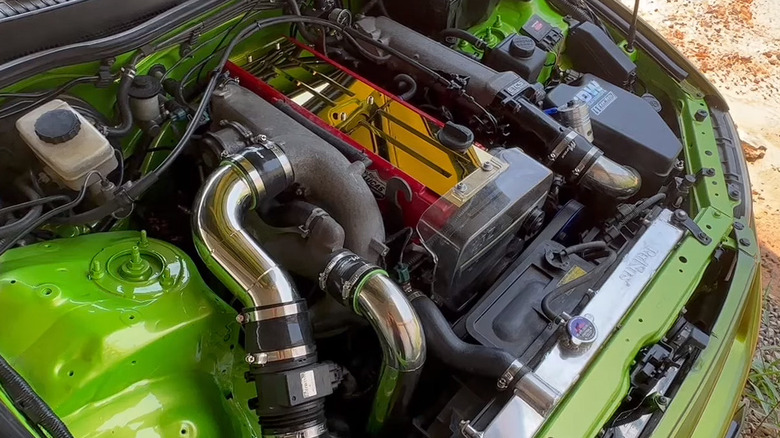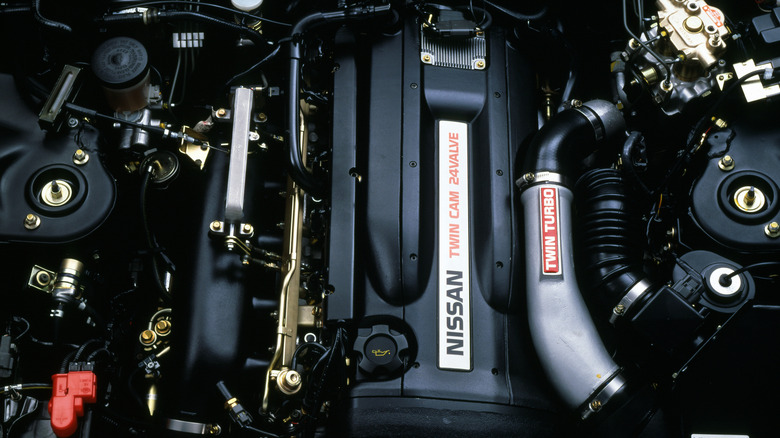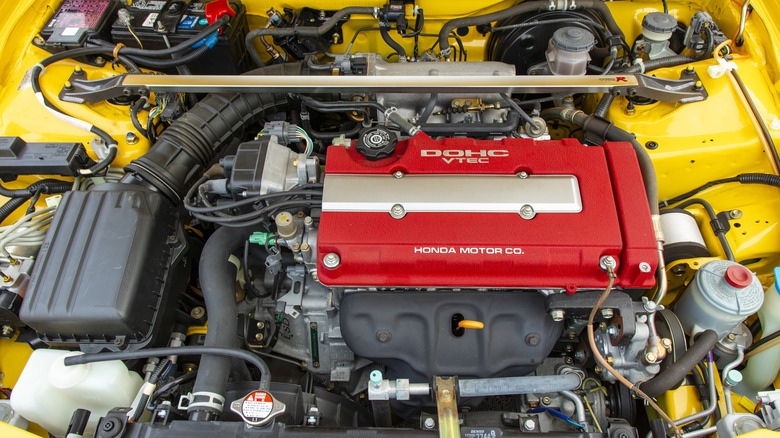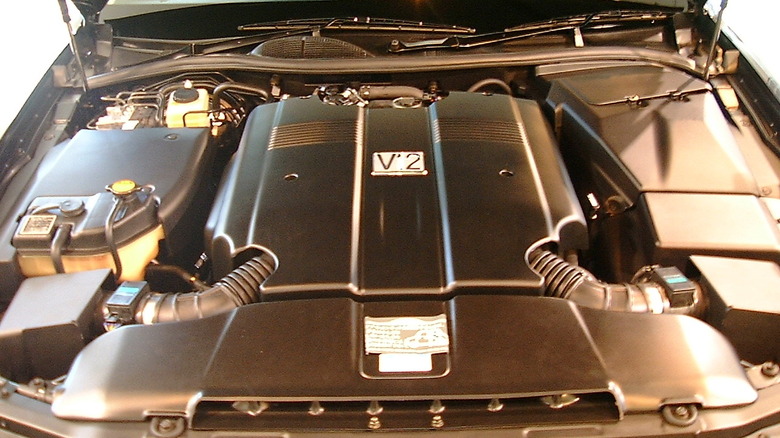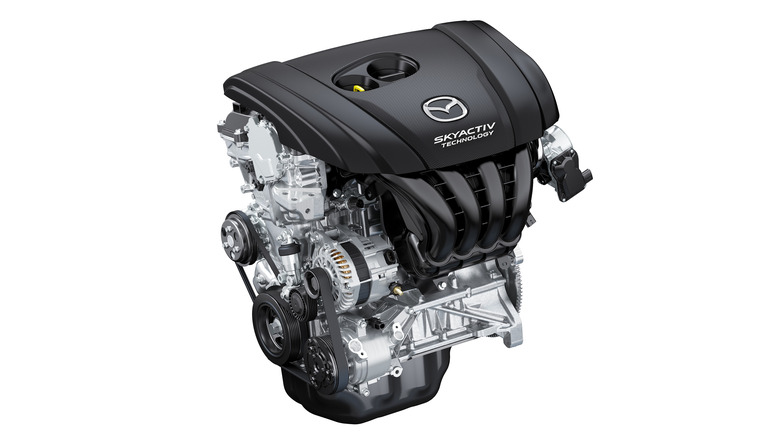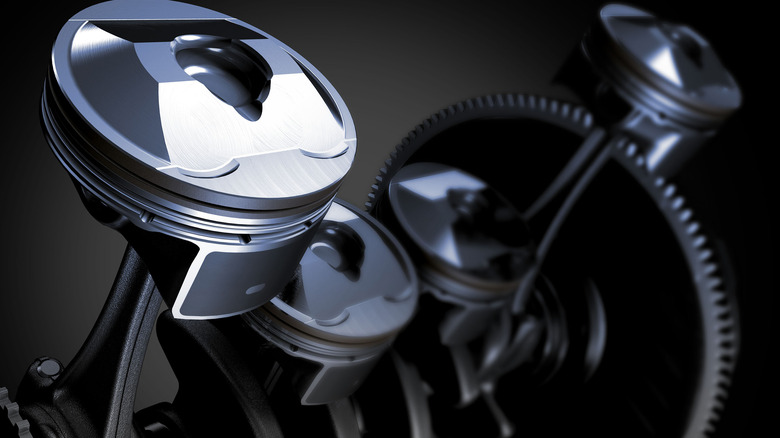10 Of The Most Reliable JDM Engines Ever Built
Ask a mechanic or an engineer who makes the most reliable engines, and the answer will probably be Japanese automakers. Sure, JDM cars are known for much more than just reliability, but that seems to be the biggest differentiating factor. Whether you are driving a Japanese off-roader or a powerful sports car, it should be reliable and long-lasting.
Durable, simple to maintain, and easy on the wallet, Japanese engines are a dream for regular drivers and car enthusiasts. Of course, not every engine from the Land of the Rising Sun is reliable, but few are terrible. Here, SlashGear will celebrate some of the most reliable JDM engines. This list has everything from regular diesels made to last a lifetime to turbocharged monsters that can endure quite a lot of tuning.
Crucially, each model on this list was proven in the real world and used in vehicles known for durability. Over-engineered, with robust blocks and strong internals, these engines embody persistence and impenetrability.
Without further ado, take a look at Japan's most reliable engines.
Toyota 1HZ
Although not frequently in the minds of JDM enthusiasts, the 1HZ is a truly legendary engine that serves as the transportation backbone in many countries globally, particularly those with bad road infrastructure. It has propelled various Land Cruiser models from 1990 until today, including the unbreakable 70 Series.
The 1HZ unit won't win any races. In fact, it's the definition of an underpowered engine. There is no turbocharger on board, and the direct injection technology was before Common Rail was a thing. As a result, this 4.2-liter inline-6 motor produces only 96 kW (129 horsepower) and 285 Nm (210 lb-ft) of torque. Predictably, driving a Land Cruiser with this engine tests the driver's patience, with acceleration almost glacial. Still, the solid torque at lower revs makes it suitable for off-road scenarios.
However, the highlight of Toyota's 1HZ engine is definitely its reliability – it simply never dies. As you probably guessed, this is a simple engine, so few things can go wrong. However, it's also built like a tank; the block and head are made from cast iron, the engine's internal components are very sturdy and overengineered, and the inline-six design means the engine is inherently balanced. Thus, covering 500,000 kilometers (310,000 miles) without a rebuild is almost the norm with this engine, with some owners covering over one million kilometers (620,000 miles) before opening the engine.
In addition, the 1HZ was designed when diesel fuel was of low quality, so it can run on almost any fuel today. Ensure regular maintenance and the 1HZ will last a lifetime.
[Featured image by Berndw~enwiki via Wikimedia Commons | Cropped and scaled | CC-BY-SA 3.0]
Nissan TD42
Toyota isn't the only company popular for making off-roaders that can reach the most remote places in the world – Nissan has been doing the same with its Patrol SUV for decades now. And if you ever wanted to mix that go-anywhere capability of the Patrol with reliability, you had to go for the TD42 diesel engine. With a similar design and capacity to Toyota's 1HZ engine, the TD42 was also built with longevity in mind.
An inline-six naturally-aspirated diesel with a 4.2-liter capacity, Nissan's engine was even more underpowered, producing 88 kW (118 horsepower) and 260 Nm (192 lb-ft) of torque. But it didn't matter, as it was still good enough to bring the Patrol to the most remote places, thanks to the SUV's off-road transfer case with short gearing.
Crucially, it's a very reliable engine, particularly if you avoid units built between 1994 and 1997, as in these model years, Nissan used thinner and lighter pistons to cut costs. Later, Nissan introduced the TD42T3, a turbodiesel variant with 114 kW (153 horsepower) and 330 Nm (243 lb-ft) of torque, which is almost as reliable as the naturally aspirated variants, thanks to the sturdier internal parts.
However, the biggest attraction of the TD42 is its unique design. Like the Toyota 1HZ, this engine also has a cast iron engine block and cylinder head, but unlike its rival's timing belt, the TD42 features a series of gears. As a result, maintenance on these engines is a breeze. You can essentially forget about a timing belt or timing chain replacements.
Honda K20 & K24
Few, if any, automakers can build natural-aspirated gas engines, as Honda does, and the K20 and K24 families are prime examples of that. Although not built for utility like the Toyota and Nissan diesels, Honda's engines are very durable and can last for hundreds of thousands of miles if maintained properly. Found in most Honda models at the turn of this century, the K20 and K24 engines powered mid-size sedans (Accord), family crossovers (CR-V), and even hot hatches (Civic Type R).
All engines in this family are fairly powerful considering the lack of a turbocharger, with the high-end 2.0-liter K20A variants producing up to 221 horsepower (217 horsepower initially) at 8,000 rpm and 159 lb-ft of torque at 6,100 rpm. Each of the K20 and K24 units has Honda's intelligent Variable Valve Timing & Lift Electronic Control (iVTEC), which helps the engine breathe better at various revolutions.
Crucially, these engines are built to stand the test of time. Featuring aluminum but sturdy blocks, a timing chain, and a forged crankshaft, a K-series engine will readily outlast many of its peers. The 2.4-liter K24 models, in particular, could go north of 200,000 miles (320,000 kilometers) before needing an engine rebuild, which is impressive for what is essentially an economy-car engine.
K20 and K24 engines are popular for engine swaps and high-horsepower builds thanks to their small size, excellent power, and sturdy nature. Still, every vehicle equipped with these motors is also a reliable second-hand purchase.
Toyota 1UZ-FE
When the first Lexus LS 400 appeared on the scene, it surprised the competition. Not only was the first true Japanese luxury car as fast and economical as its German and American rivals, but it was also quieter, more comfortable, and, most importantly, more reliable. Since the first LS, Lexus has been winning reliability and dependability surveys, showcasing Japanese engineering.
At the heart of it all was the 1UZ-FE V8 engine with a 4.0-liter capacity, DOHC, and 32 valves. It produced 250 horsepower and 260 lb-ft (353 Nm) of torque in its initial form. Underpowered by today's standards, yes, but at the time, 7.9 seconds to 60 mph and a 150-mph (240 km/h) top speed were pretty good. Besides, the buttery-smooth engine gave the Lexus LS 400 refinement that was far exceeding its price point.
Most importantly, this is one of the most reliable V8 engines on the planet, period. Although it has an aluminum block for weight savings, the cylinder linings are made from cast iron. Furthermore, it has a forged crankshaft, forged connecting rods, induction hardened connecting-rod pins, hypereutectic pistons, and six cross-bolted main bearing caps. As a result, the overengineered 1UZ-FE frequently lasts for hundreds of thousands of miles without any significant breakdown.
There is even a million-mile (1.6 million kilometers) Lexus LS 400, which passed that figure without the engine ever being opened. This is unsurprising because Toyota clocked 1.67 million miles (2.7 million kilometers) of real-world testing globally, including the hottest and coldest places.
Subaru EJ22
Subaru engines don't often appear in lists like this, but the EJ22 is an exception. This 2.2-liter flat-four, produced from 1990 to 2001 and adorning various Subaru models, is a very sturdy unit and perhaps the most reliable Subaru engine. Therefore, it's worth a look for those in the market for a 1990s Japanese classic. Producing anywhere from 135 horsepower (naturally aspirated) to 280 horsepower (turbocharged), there is an EJ22 engine option for everyone – even those looking for some rally-inspired fun.
The EJ22 is a four-cylinder boxer engine, which is inherently balanced, with perfect primary and secondary balance. Therefore, it operates more smoothly than regular inline-4 engines, aiding durability. However, Subaru has also done proper work with the engine design. Notably, the EJ22 family features an all-aluminum design (block + head) and cast-iron cylinder liners, providing the necessary strength and longevity. Latter naturally-aspirated versions also received redesigned, molybdenum-coated pistons for decreased weight and friction and longer lifespan.
However, the turbocharged versions are even more impressive, with reliability and longevity that surpasses many similar engines of the era. For instance, the 280-horsepower version seating inside the 1998 Subaru Impreza STi 22B had a closed-deck design and oil sprayers for the forged pistons. As a result, despite being a high-performance turbocharged engine with a 7,900 rpm redline, the EJ22G has a lifespan of over 250,000 miles, with some versions reaching up to 500,000 miles.
Toyota 1JZ/2JZ
The 1JZ 2.5-liter and 2JZ 3.0-liter family of Toyota inline-6 engines are mostly known for their "GTE" twin-turbocharged variants, which adorned cars like the legendary MKIV Supra and sporty Chaser sedan. However, this lineup of engines also has naturally aspirated variants, adorning cars like the Lexus GS 300 and IS 300 (2JZ) and Toyota Soarer and Crown (1JZ).
Whichever version you choose, though, you can expect stellar reliability. The 1JZ and 2JZ engines can easily go over 300,000 miles without a significant rebuild. That is largely thanks to the strong cast iron block, forged rods, and forged crankshaft, as well as the fact that all of these engines are relatively underpowered when stock. In fact, they are some of the most popular engines for high-horsepower tunes, mainly due to the sound construction.
Between the many options in the 1JZ and 2JZ family, the non-VVTi models are more reliable. Namely, the actuator of the VVTi system is a weak point and could fail, requiring the removal of the cylinder head. Also, oil frequently leaks from the cam gear, requiring a replacement of the seals. Meanwhile, the factory turbochargers are less reliable than the engine itself, though regular maintenance largely solves the problem.
Still, these issues are just minor annoyances and easily repairable, so don't shy away from the VVTi variants. They are more durable than similar six-cylinder machines from the 1990s, anyway. Crucially, both the 1JZ and 2JZ engines are built like tanks inside and rarely require engine-out service. That is, of course, if you aren't already putting even stronger forged components inside to break the mythical 1,000-horsepower barrier.
Nissan RB26
Like its biggest rival, the 2JZ, the RB26 family of engines is mostly known for the legendary DETT twin-turbocharged variant. Still, each version of these over-engineered 2.6-liter inline-6 engines is known for its durability and dependability. It adorned various Nissan vehicles in the 1980s and 1990s, including the R32, R33, and R34 Skyline GT-Rs, Nissan Stagea 260RS Autech, and Cefiro A31.
Featuring cast-iron blocks and strong internals, RB26 engines can run over 200,000 miles before a significant engine rebuild is necessary. That is true even for the twin-turbocharged DETT variant, which is usually driven hard. Moreover, the high-performance version features sodium-filled exhaust valves, extra counterweights in the crankshaft, I-beam connecting rods, and special cooling channels under the pistons. As a result, most parts inside these engines are cooled adequately, ultimately resulting in a longer-running engine.
Like every engine ever made, RB26s have some weak points. For instance, oil supply is a problem on these engines, especially when driven hard. Fortunately, replacing the oil pump with an aftermarket one from a reputable company will resolve the issue and keep the engine ticking.
Its racecar nature sets the RB26 apart from other engines on this list. An over-square design with an 86.0-millimeter bore and 73.7-millimeter stroke, it is a rev-happy engine, unlike the 2JZ. It's lighter, too. For that reason, it's very popular as a swap engine, particularly for handling-oriented project cars made for track sessions.
Honda B18
Honda's B-series engines, consisting of 1.6, 1.7, 1.8, and 2.0-liter capacities, are famous for their high-rev nature and excellent performance without forced induction, as well as their affordability and reliability. The B18 family, in particular, is famous for being well-engineered and durable.
That is particularly true for the early non-VTEC variants, which were very sturdy and could go almost 250,000 miles (400,000 kilometers) before an engine rebuild. Even the most extreme variant, the mythical B18C, can go up to 200,000 miles (320,000 kilometers) with regular maintenance. That doesn't sound like much, but remember that the most powerful B18C in the Acura/Honda Integra Type R produced an impressive 200 horsepower at an astronomical 8,000 rpm and had an 8,900-rpm rev limiter. Few, if any, other high-strung engines could come close to that lifespan.
Crucially, B18 engines have sound basic parts, like a strong block and internal components. Thus, they rarely fail catastrophically, particularly when oil change and timing belt replacement intervals are timely. Still, secondary parts, like the thermostat and water pump, are not very durable, so they should be considered regular maintenance items.
Toyota 1GZ-FE
You have probably heard about Toyota's JDM-only Rolls-Royce killer, the Century sedan. A vehicle that sits above Lexus in Toyota's pecking order, the Century is a meticulously designed machine focused on ultimate quietness, comfort, and refinement. An integral part of that experience, at least in the second-gen model, was the state-of-the-art 1GZ-FE — the only Japanese V12 engine ever made.
Effortless and creamy, the Century V12 is one of the smoothest engines in existence. Toyota also created a very reliable and durable machine, yielding the most polished engine possible. For instance, Toyota's engineers used the company's VVTi system, iridium electrode spark plugs, and slant-squish combustion chambers to stabilize each cylinder's combustion.
Moreover, they made every part more rigid and manufactured it to very tight tolerances, all in the name of maximum refinement. This, inadvertently, also made the engine more robust and durable. Notably, the 1GZ-FE features a forged steel crankshaft and valve shims coated with titanium, which are parts usually installed in racing engines – not an underpowered luxury V12. At 5.0-liter capacity, the 1GZ-FE produces only 276 horsepower (due to the JDM automakers gentlemen's agreement), so no internal part is stressed near its limit. Heck, Toyota even installed two ECUs for each cylinder bank, so if one fails, the engine will continue to run on six cylinders.
Due to its overengineered nature and the use of exotic parts, the average lifespan of the 1GZ-FE engine is almost 300,000 miles. It's also becoming increasingly popular in tuning circles since Smokey Nagata put this V12 in a 1,000-horsepower Toyota Supra.
[Featured image by Ypy31 via Wikimedia Commons | Cropped and scaled | CC0 1.0]
Mazda SkyActiv-G
Mazda is most famous in enthusiast circles for its persistence in perfecting the rotary engine. However, the company also implemented unusual engineering ideas in regular internal combustion engines. For instance, its SkyActiv-G family of naturally aspirated inline-four gas engines has a 14.0:1 compression ratio, similar to a diesel engine. A higher compression ratio equals higher efficiency, but gas engines significantly increase the likelihood of detonation, particularly when running on low-octane fuels. And if it happens enough times, this explosive combustion can wreck the piston and its rings in no time.
But Mazda wouldn't be Mazda if it didn't overengineer these engines and make them stupendously reliable. So, the company's engineers took to solve the biggest culprit of detonation – high temperatures inside the combustion chambers. They used Dual S-VT (Dual Sequential Valve Timing), which allowed the engine to breathe better at various revolutions, and a low-resistance 4-2-1 exhaust design. Furthermore, a high-pressure direct injection system injected fuel at the right time. Crucially, it injected the fuel inside a small combustion well on the domed pistons, thus keeping it away from the hot cylinder walls.
These clever solutions made SkyActiv-G engines efficient, though not very powerful. Still, due to the under-stressed nature, these engines can last long without any engine-out service. SkyActiv-G engines with 150,000+ miles are becoming increasingly common and still run like clockwork. The only real issue you might encounter is low oil pressure, though even that is fairly rare.
How did we choose these engines?
Since not many regulatory bodies test engine reliability (they only do that on the whole car), we used real-world experiences of people owning various Japanese vehicles to find the most reliable engines. Naturally, this meant reading through various forums, but we also injected some of our expertise, as the writer of this article also has experience and accumulated knowledge of Japanese cars.
If you think we forgot some engines, remember that this list is not definitive, as these are just 10 of the most reliable JDM engines. Surely, certain engines are more reliable than some on this list. Still, we included various designs to make for more worthwhile reading.
